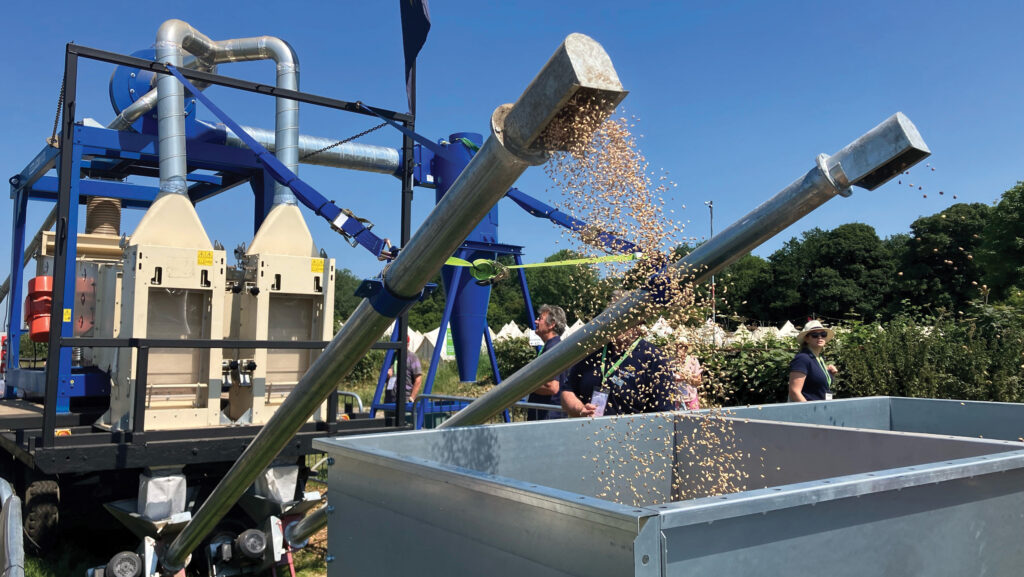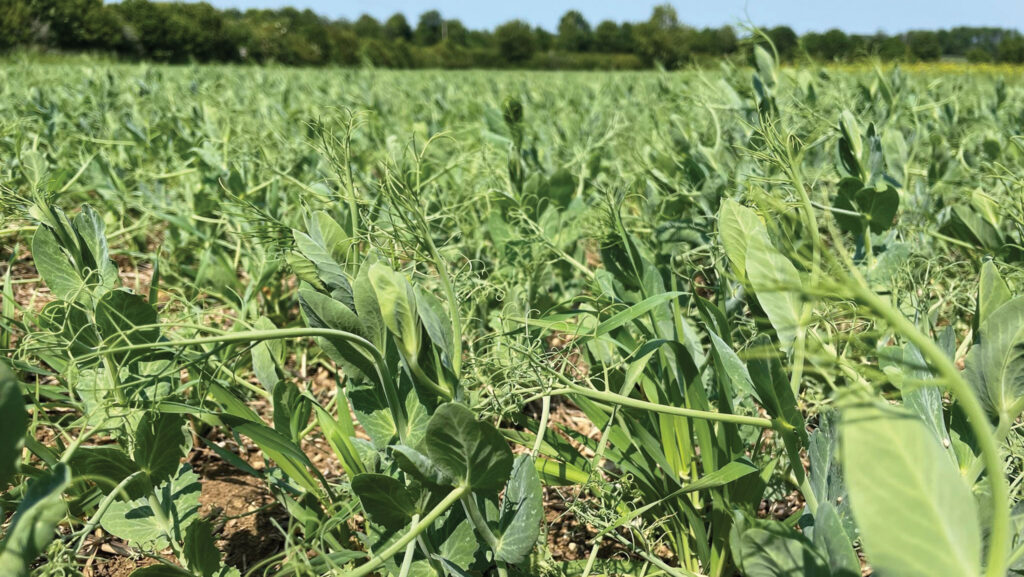Getting the most from intercropping: Your questions answered
 © MAG/Emma Gillbard
© MAG/Emma Gillbard Intercropping is becoming a popular option for arable farmers looking to reduce chemical inputs and enhance yields.
Particularly as the Sustainable Farming Incentive pays £55/ha for companion cropping.
Despite its many benefits, which include weed and disease suppression, intercropping remains a relatively niche practice.
See also: Video: Organic spring wheat and bean bicrop hits hefty premium
Intercropping in modern farming systems
In fact, only 2% of European arable land is used for legume-cereal intercropping.
Many farmers still question how the practice fits into modern farming systems.
These queries range from selecting the right varieties, to calculating optimum seed rates, harvest, separation and marketing.
Helping address these concerns is the Innovative Farmers UK field lab on cereal/legume intercropping, which is part of the Horizon Europe Leguminose project.
The project aims to investigate the benefits of intercropping, and break down the barriers which are preventing it from being mainstream.
Bringing together 17 industry partners from across Europe, including UK partners Reading University and the Soil Association, the collaboration is funded by Horizon Europe and Ukri.
Jerry Alford, senior advisor at the Soil Association and coordinator of the field lab, answers some frequently asked questions on intercropping and shares some of this season’s farm trial results.

Jerry Alford © Soil Association
How should I select crops for intercropping?
Choose species that will grow well together, ideally ones that are planted and harvested around the same time.
Peas and barley seemed to be a particularly good performer in trials this harvest.
It’s especially important to pick varieties with similar harvest dates – compatibility is important.
This year, a few of the triallists had issues with crops not maturing together.
This was particularly true for beans and oats, where the oats were ripe but the beans were not. This was likely due to low light intensity levels throughout the growing season.
Farmers are often opting for earlier maturing bean varieties, but perhaps the focus should now be on later maturing oat varieties.
We are still learning the best crop combinations and timing for successful intercropping – it certainly is a challenge to balance.

© Ben Adams
How does intercropping affect pest and disease levels?
The diversity in the field makes it harder for pests and disease to spread quickly.
Different crops are susceptible to different pests and diseases, so mixed crops provide protection.
We also think that healthier soil (often the result of intercropping) makes the plant more resilient.
While much of the evidence is anecdotal, many farmers say they deal with fewer pest and disease problems when they intercrop.
Trial results revealed intercropped beans suffered 11% less bruchid beetle damage than monocrop beans, with 14% in the intercrop compared with 25% damage in the monocrop.
About 5% of intercropped peas suffered pea moth damage compared with 10% in the monocrop.
We also discovered that monocrop peas were more susceptible to pigeon damage.
There was also evidence of deer and badger damage in the monocrop wheat but not the wheat/bean intercrop.
Perhaps this was linked to the animals not wanting to track through the stiffer-stemmed bean stalks.
What about weed suppression?
Intercropping has the potential to reduce weed and consequently reduce reliance on herbicides.
However, herbicide use can be restricted when intercropping so growers should consider crop choice and weed control as part of a wider rotation.
In one of this year’s trial plots, volunteer phacelia was found to be lower in the intercrop compared to monocrop.
In a separate pea and barley trial, there were lower cleaver weed seed counts recorded in the intercrop.
The pea monoculture experienced 27g of cleaver seeds for every 200g of pea sample. The barley monoculture had 17g of cleaver seeds, while the intercrop was 7g.
What are the options for harvesting intercrops?
Typically, intercrops are harvested together as a combined crop. This means you choose two species that ripen at the same time and run them through the combine together.
The challenge is managing different types of crops, like small grains and larger beans, which need careful setup for the combine. It can be tricky, but it’s definitely doable.
After that, you can sell the crops separately or as a combined product, which is especially handy for the animal feed market.
Do you need to separate intercrops post-harvest?
The ability to separate does provide marketing opportunities, although livestock producers will be able to utilise the mixed product.
Crop separation is an additional operation and is dependent on the two crops being different sizes, although machines separating based on colour do exist.
Existing on-farm cleaners can be used, but may require a little adaptation to separate the two crops, as well as dust, trash and weed seeds, to reach market specification, particularly for human consumption markets.
Does intercropping improve overall yield?
While we’re still waiting for the final trial results, intercropping usually gives a higher total yield for every unit area compared to growing single crops.
Farmers often get 1.2-1.3 times more yield a hectare when they combine the output of both crops, although the yield of each individual crop might not increase.
Does intercropping reduce the need for fertiliser?
Legumes can fix their own nitrogen, meaning they don’t need artificial fertilisers.
Intercropping can boost soil structure and increase levels of nutrients like nitrogen, phosphate, and potash.
The expectation when growing legumes with cereals is that the legume will support the cereal.
All trials carried out soil analysis – greater soil nitrogen reserves were identified following cereals grown with beans.
However, in the peas and spring barley intercrop, lower nitrogen was recorded, but we were unsure why.
There’s research exploring whether applying low levels of fertiliser early in the season might be beneficial.
There are also indications that wheat in wheat-bean intercrops may have a higher protein content due to late-season nitrogen. The timing and quantity of fertiliser is also being researched.
Get involved
The UK field lab aiming to increase the uptake of cereal/pulse intercropping, is now entering its second year.
A total of 12 farms across the UK were involved in trials last year growing a combination of beans and wheat, beans and oats, peas and barley and peas and oats.
However, trials were seriously affected by the wet winter and spring, with some plots unable to be planted or failed to establish.
If you are interested in taking part in the intercropping trials this season, have an idea you’d like to test or would like to find out more, contact Jerry at jalford@soilassociation.org.
The Soil Association is keen to involve farmers from all regions and systems to ensure the trials are as diverse as possible.
Leguminose N fertiliser experiments
Latest research at the University of Reading on nitrogen (N) use in wheat-legume intercrops has been investigating how much N fertiliser can be cut, and how this impacts nitrogen losses.
University researcher Dr Imelda Uwase explains the preliminary results from this season’s Extase winter wheat and Tundra bean field trial.
“Nitrogen rates of 0kg, 90kg, 135kg, 180kg and 225kg N/ha were tested on the monocrop wheat, while half rates were applied to the intercrop.
“Fertiliser was applied in two doses,” she says:
- There was no significant difference between wheat and faba bean yields grown together compared with separately, highlighting bicropping did not restrict production
- Intercropped wheat produced similar yields to monocrop wheat, despite using half the nitrogen fertiliser a hectare
- Wheat-faba bean intercropping reduced nitrate leaching, with lower nitrous oxide (N2O) emissions in intercropping after N fertilisation, coinciding with lower N application rates
- There was no difference in N2O emissions between intercrops and monocrops without N fertiliser.
This season, a second set of trials have been drilled, with a larger sample size. Further analysis on nitrate leaching and nitrous oxide emissions will take place.

